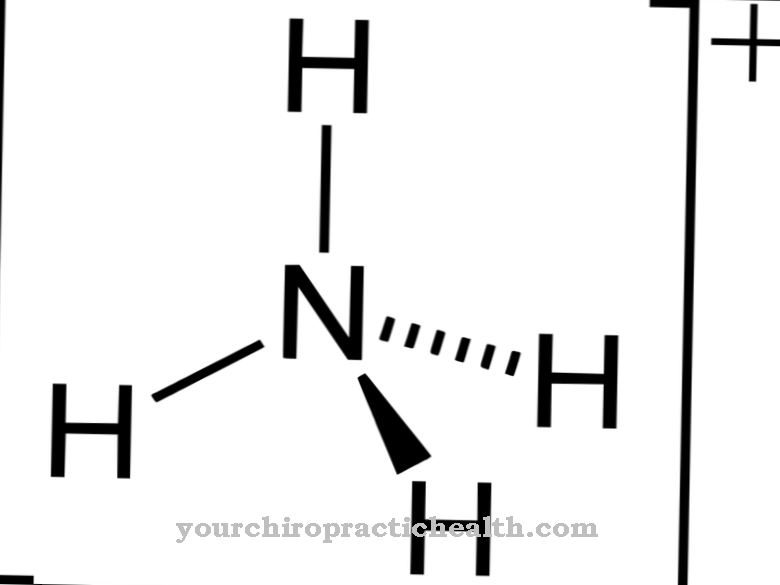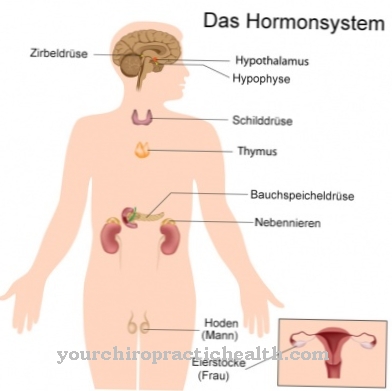The body's own hormone Adiuretine or. Antidiuretic hormone is formed by nerve cells in the hypothalamus, part of the human [[diencephalon] s. Its main purpose is to control the water balance in the body. An imbalance in quantity and production can trigger a number of diseases.
What is the Antidiuretic Hormone?
.jpg)
Adiuretin is also known under the names ADH (antidiuretic hormone), vasopressin and AVP (arginine vasopressin). The most common is the name ADH, which is composed of the words "anti" for "against" and "diuresis" (= urinary excretion through the kidneys). Since the hormone promotes the recovery of water from the kidneys, it counteracts urine excretion, which explains the name.
In addition to oxytocin, ADH is an effect hormone of the hypothalamus.This group of hormones acts directly on the cells of the target organs without taking a detour via body glands. The basic structure of ADH consists of the amino acids phenylalanine, cyctein, arginine, tyrosine, glutamine, asparagine, proline and glycine.
Production, Education & Manufacturing
In the human body, adiuretin is made together with oxytocin in the hypothalamus, an area of the diencephalon near the optic nerves. It is then released into the bloodstream.
The amount of ADH that is released is determined by the osmotic concentration of the blood. The water balance of the human body is regulated by osmosis - the balance between the particles of a liquid through a semi-permeable membrane. If there is a lack of water in the human body, more adiuretin is released.
There are sensors in the hypothalamus that record and transmit the osmotic concentration. Blood pressure also plays a major role in regulating the amount of ADH released - the corresponding sensors are located in large blood vessels.
Function, effect & properties
The most important function of ADH is the regulation of the water balance. The hormone uses receptors on the kidneys' collecting pipes to direct water back into the body. This increases the concentration of the urine as it decreases in volume. In healthy people, this process is particularly evident at night, as it is possible to sleep through the night without urinating.
Adiuretine also fulfills other tasks. In large quantities, it causes the blood vessels to constrict, which in turn increases the blood pressure. In the liver, the hormone causes sugar to be released to other organs (glycolysis). This need arises when the body has an increased energy requirement, in which the sugar from food is insufficient to optimally supply the cells.
Some of the adiuretin is not brought into the bloodstream, but rather migrates to the anterior pituitary gland. There it causes the release of ACTH (adrenocorticotropin). This peptide hormone ensures the release of the body's own cortisol (glucocorticoids) in the adrenal gland and is therefore also responsible for the release of insulin. Since ADH is at the beginning of this chain, it is also one of the components of the hormonal stress mechanism.
Illnesses, ailments & disorders
Disruptions in the production of ADH can manifest as both overproduction and underproduction, the latter being much more common. In diabetes insipidus centralis, the organism has too little ADH. There are many reasons. A lack of or insufficient production of adiuretin or a lack of transport to the posterior lobe of the pituitary gland can be just as responsible as insufficient storage in the hypothalamus or lack of transport to the body cells. The consequences are the same in all cases, since no or too little ADH arrives at its destination to develop its effect.
The main symptoms are increased urination and severe thirst. People lose urine without drinking a lot. Additional symptoms can include dry skin, difficulty sleeping, irritability, or constipation. The disease can be diagnosed by laboratory tests, in particular by the thirst test: the patient is examined in a laboratory after a few hours without being given fluids. A healthy person shows an increase in ADH due to thirst, which cannot be recorded in a sick person.
A rare disorder associated with adiuretin consists of overproduction of the hormone - Schwartz-Bartter syndrome. There is an excess of water in the organism, which causes those affected to gain weight. It also thins the blood, causing symptoms from the low level of sodium. Drowsiness, headaches or a feeling of disengagement are the consequences. The thinning of the blood is often determined through a routine examination. In addition, a urine test can show that the urine is too concentrated.
In both cases, the causes are extremely diverse. Often it is benign or malignant tumors of the hypothalamus, cerebral haemorrhage after accidents, vascular inflammation, a cyst or, more rarely, granulomatosis. In most cases, the disease can be treated well by removing the underlying problem.
You can find your medication here
➔ Medicines for bladder and urinary tract health



.jpg)








.jpg)



.jpg)










.jpg)
